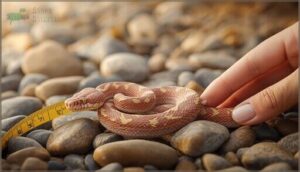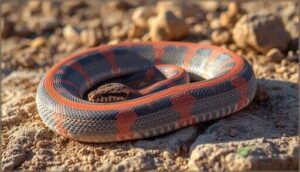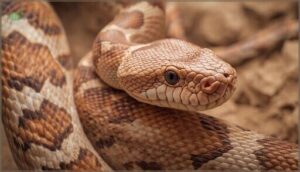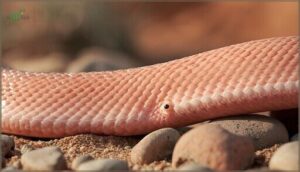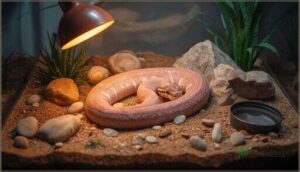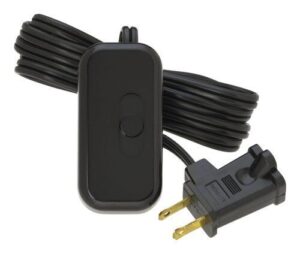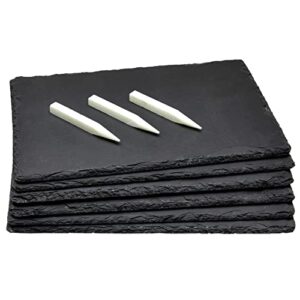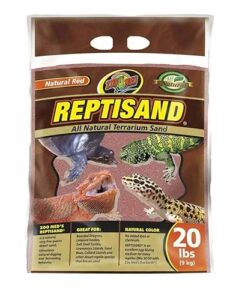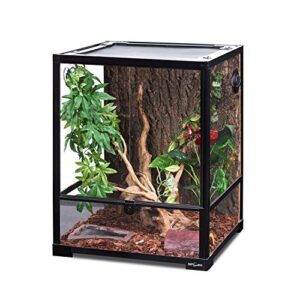This site is supported by our readers. We may earn a commission, at no cost to you, if you purchase through links.
Most snake owners dream of a pet that stays compact, tolerates handling, and doesn’t demand tropical rainforest conditions in their living room. The rosy boa checks all those boxes. This small, muscular constrictor tops out around three feet, sports striking longitudinal stripes in shades of rust, cream, and chocolate, and thrives in straightforward desert setups that won’t spike your electricity bill.
Native to the rocky scrublands of the American Southwest, rosy boas have mastered the art of thriving where most snakes would struggle—granite outcrops, talus slopes, and sun-baked canyons where temperature swings are brutal.
That same hardiness translates beautifully into captivity, making them one of the most forgiving snakes for keepers who want a low-maintenance species that still delivers on personality and visual appeal.
Table Of Contents
- Key Takeaways
- Rosy Boa Physical Characteristics
- Natural Habitat and Geographic Range
- Essential Rosy Boa Care and Husbandry
- Top 5 Products for Rosy Boa Care
- Frequently Asked Questions (FAQs)
- Are rosy boas friendly?
- Are rosy boa venomous?
- Do rosy boa like to be held?
- What size tank does a rosy boa need?
- How long can rosy boas live in captivity?
- Are rosy boas good pets for beginners?
- When is the best time to handle rosy boas?
- Can rosy boas be housed together safely?
- What are common health issues for rosy boas?
- How often do rosy boas shed their skin?
- Conclusion
Key Takeaways
- Rosy boas stay small (2-3 feet), tolerate handling well, and thrive in straightforward desert setups with minimal humidity requirements, making them one of the most forgiving snake species for beginners.
- These snakes need a 20-40 gallon enclosure with a thermal gradient (90-92°F warm side, 70-75°F cool side), 3-4 inches of substrate for burrowing, and at least two secure hides to mimic their natural rocky desert habitat.
- Feeding is simple—offer frozen-thawed mice every 5-7 days for juveniles and every 10-14 days for adults, matching prey width to the snake’s thickest point while keeping portions at 10-15% of body weight.
- With proper care, rosy boas can live 20-30 years in captivity and rarely bite, making them ideal long-term companions that require minimal daily maintenance beyond basic temperature monitoring and occasional feeding.
Rosy Boa Physical Characteristics
Rosy boas are small, muscular snakes that pack a lot of personality into a compact frame. Their appearance varies quite a bit depending on where they come from, with coloring that reflects their desert home.
Let’s break down what makes these boas so distinctive.
Size and Weight
Your rosy boa (Lichanura trivirgata) will grow steadily but slowly. Most adults reach 2-3 feet in length, though some stretch to 44 inches. Expect your pet snake to weigh around 11-21 ounces at maturity. Females generally outsize males by several inches and a few ounces.
Growth rates average 1-2 inches yearly, with full adult body mass achieved around 3-4 years. To guarantee proper growth, understanding rosy boa care is essential for providing the right environment.
Coloration and Patterns
Your rosy boa’s color scheme tells a geographic story. Nearly all specimens sport three longitudinal stripes—one down the back, two along the sides—ranging from rosy orange to deep maroon against cream, tan, or blue-gray ground colors.
Pattern morphs vary wildly by locality: Morongo Valley snakes flash bright orange on slate backgrounds, while Maricopa Mountain individuals wear brown stripes over cream. Some show rosy ventral tones; others display spotted bellies instead.
Understanding the rosy boa habitat is vital for creating an ideal environment for these snakes.
Head, Eyes, and Body Shape
Beyond those striking stripes, your rosy boa’s cranial structure reveals a narrow, elongated head barely wider than the neck—perfect for slipping into rocky crevices. The body proportions tell another story: a thick, cylindrical trunk about the size of a golf ball in diameter supporting that modest head.
- Small eyes with vertical pupils adapt these reptiles for nighttime hunting
- Smooth scalation patterns (33–49 midbody rows) reduce friction against desert rocks
- Short, blunt tail mimics the head shape, confusing predators when threatened
Distinguishing Features
What really sets your rosy boa apart from lookalike boids? Two claw-like anal spurs flanking the vent—vestigial hind limbs absent in most colubrids.
You’ll spot smooth, non-keeled scalation types spanning 33–49 midbody rows, while stripe patterns range from sharply defined desert forms to broken coastal variations.
Unlike rubber boas or boa constrictors, Lichanura trivirgata displays distinct longitudinal striping and uniquely rosy ventral color on many specimens.
Natural Habitat and Geographic Range
Understanding where rosy boas come from helps you create a setup that feels like home. These snakes aren’t scattered everywhere—they stick to specific corners of the Southwest with rocky terrain and desert scrub.
Let’s break down their native turf and what makes those spots work for them.
Native Regions and Distribution
You’ll find rosy boas (Lichanura trivirgata) scattered across a surprisingly wide geographic range—but don’t expect them everywhere. Their southwestern states stronghold includes:
- Southern California’s desert and coastal zones
- Southwestern Arizona’s rocky Sonoran Desert stretches
- The entire Baja Peninsula, from border to tip
- Northwestern Sonora, Mexico, hugging the U.S. line
This Mexican distribution extends their reach deep into desert habitats where rocks meet resilience.
Preferred Environments
These snakes thrive where rocks and desert scrub collide—talus slopes, granite outcrops, and boulder-strewn hillsides dominate their world. You’ll spot them near canyon streams and washes, where arid microclimates under stones offer cool refuge from scorching surface temperatures.
| Habitat Feature | Natural Condition | Captive Equivalent |
|---|---|---|
| Rocky outcrops | Granite piles, talus | Secure rock hides |
| Desert landscapes | Creosote scrub zones | Dry enclosure substrate |
| Thermal gradients | 65–90°F range | Warm/cool side setup |
| Humidity levels | ~40% ambient | Low humidity substrate |
| Arid microclimates | Subsurface burrows | Ground-level hide boxes |
Desert habitat setup mimics these rocky, low-humidity strongholds where temperature and shelter meet survival.
Adaptations to Desert Life
Your rosy boa’s desert LAIR demands survival tools you can replicate in habitat setup—water conservation through prey-rich diets, thermal regulation via burrowing behavior, and metabolic adaptation that sustains months of fasting. These snakes own their ecological niche through:
- Cutaneous water loss under 0.5 mg/cm²/h
- Body temps maintained at 28–32°C using rock crevices
- Subsurface temps 5–15°C cooler than surface
- Desert camouflage matching local substrate tones
- Uric acid excretion minimizing water waste
Shelter and Activity Patterns
Your rosy boa thrives as a nocturnal hunter, emerging from rock crevices and burrows after dark when temps hit 24–30°C. Shelter selection drives survival—they spend over 70% of their time hidden under rocks or in burrows, using thermal gradients between warm (29–32°C) and cool zones.
Rosy boas are nocturnal hunters that spend over 70% of their time hidden in rock crevices, emerging only when temperatures reach their preferred 24–30°C range
Proper habitat setup mimics this: provide at least two secure hides in your tank to support natural activity cycles and burrowing habits.
Essential Rosy Boa Care and Husbandry
Setting up the right home for your rosy boa isn’t complicated, but it does require attention to a few key details. From choosing the right enclosure to nailing down feeding schedules, good husbandry keeps your snake healthy and stress-free.
Let’s break down what you need to know to create a comfortable setup.
Enclosure Size and Design
Your rosy boa needs at least 30 inches of enclosure length—think 20-gallon long tanks for smaller adults, but 40-gallon breeder tanks work best. Horizontal space beats height since these are ground-dwellers that need room to roam and establish thermal gradients.
Make sure your tank has secure, escape-proof lids and enough floor area for proper heating zones and future substrate setup.
Substrate, Hides, and Decor
You’ll want a substrate mix that holds stable burrows—try 60% reptisoil with 40% reptisand, or blend organic topsoil, play sand, and clay. Aim for 3–4 inches deep so your rosy boa can dig without collapse.
- Place at least two hides (one warm, one cool) or use flat rocks your snake can retreat under
- Add cork flats, cholla wood, or sturdy branches for climbing enrichment
- Anchor heavy rock structures before adding substrate to prevent dangerous collapses
Heating, Lighting, and Humidity
Once your hides and substrate are set, dial in temperature gradients with heating equipment. Run an under-tank heater or heat tape on a thermostat to reach 90–92°F on the warm end, dropping to 70–75°F on the cool side. Track both zones with an infrared temperature gun—accuracy matters. UVB lighting stays optional, but a 10–12 hour day cycle keeps rhythms natural. Hold humidity around 40%, spiking to 60% during sheds only.
| Parameter | Target Range | Equipment |
|---|---|---|
| Basking spot | 85–90°F | Halogen flood bulb, thermostat |
| Warm-side ambient | 80–85°F | Under-tank heater, heat tape |
| Cool-side ambient | 70–75°F | No heating (natural gradient) |
| Humidity | 40% (60% in shed) | Digital hygrometer, water dish |
Feeding, Diet, and Nutrition
Your boa’s meal plan drives energy, growth, and long-term vitality. Offer frozen–thawed mice or young rats every 5–7 days for juveniles, stretching to 10–14 days once they hit adult size. Prey selection matters—match width to your snake’s thickest point and aim for 10–15% of body weight per feeding. Skip live rodents; frozen options prevent bites while keeping nutrient balance intact.
Four pillars of smart snake feeding:
- Prey Selection – Mice, young rats, or day-old chicks matching body width
- Meal Portioning – 10–15% of snake weight per meal to avoid obesity
- Feeding Schedule – Weekly for juveniles; biweekly for adults
- Dietary Supplements – Rare dust or gut-load if you rotate food sources
Handling, Temperament, and Health
Once your feeding routine settles, you’ll notice your rosy boa’s mellow temperament shine—most stay calm during brief weekly handling sessions. Wait 48 hours post-meal to avoid regurgitation, then support the body gently.
Watch for stress signals like persistent hissing or refusal to eat; respiratory infections and scale rot emerge when humidity or cleanliness slip. Wash hands after every snake handling session to dodge Salmonella.
Top 5 Products for Rosy Boa Care
Setting up a proper home for your rosy boa doesn’t have to be complicated, but having the right gear makes all the difference. You’ll want tools that help you monitor temperature, create hiding spots, and maintain the desert-like conditions these snakes need to thrive.
Here are five must-have products that’ll make your rosy boa care routine easier and more effective.
1. Lutron Plug In Dimmer Switch
You might think a plug-in dimmer switch helps manage your rosy boa’s tank temperature, but here’s the catch—it won’t do the job safely. The Lutron dimmer can adjust light intensity on basking bulbs, but it doesn’t provide thermostat control or feedback-based heat management your snake needs.
Without actual temperature regulation, you risk dangerous fluctuations that could harm your boa. For reliable care and electrical safety, you’ll want a proper reptile thermostat instead of relying on a simple dimmer for heat.
Best For: People who want to adjust the brightness of table or floor lamps with incandescent or halogen bulbs, but not suitable for controlling reptile heating systems where precise temperature regulation is critical.
- Simple plug-in design means no electrical wiring or installation hassle—just plug it in between your lamp and wall outlet
- Smooth slide control lets you dial in exactly the light level you want, from bright to dim
- Works with high wattage loads up to 300 watts for incandescent bulbs, giving you flexibility for larger lamps
- Not compatible with most LED or CFL bulbs, which limits your lighting options in modern setups
- Doesn’t regulate temperature or provide feedback control, making it unsafe for reptile heating despite adjusting bulb brightness
- Can only dim lights manually without any automated or thermostat features, so you’ll need constant adjustment for consistent results
2. Mini Black Slate Charcuterie Boards
These six-piece slate sets look elegant for entertaining guests, but they’re a terrible choice for your rosy boa’s tank. Each board weighs about 0.67 pounds and measures roughly 8 x 11.8 inches—completely useless as a hide or substrate.
Food safety guidelines and board cleaning methods matter for charcuterie presentation, not snake care. Slate durability testing confirms these boards chip easily under reptile conditions.
Skip the decorative slate board maintenance headaches and invest in proper pet tank equipment designed for your boa’s actual needs instead.
Best For: Home entertainers who want an affordable, elegant way to serve cheese, meats, and appetizers at parties and holiday gatherings.
- Comes as a set of six boards with chalk for labeling, giving you plenty of pieces for around $7-8 per board
- Heat-resistant slate keeps food at the right temperature when pre-chilled or warmed
- Easy to clean with warm soapy water and reusable across multiple events
- Some customers report scratches, dents, and inconsistent thickness out of the box
- Slate absorbs oils and can stain permanently if you don’t clean it right away
- Not dishwasher-safe, and you may need to seal boards with mineral oil to prevent staining
3. Infrared Laser Temperature Gun Tool
You need precise temperature control in your rosy boa’s tank, and this infrared tool delivers instant surface readings across the thermal gradient.
Point the laser accuracy beam at basking spots, hides, and cool zones to verify your setup stays within the 70–90°F range your snake requires.
Most units come factory-set to 0.95 emissivity adjustment—perfect for reptile care surfaces without fiddling with infrared settings.
The 12:1 distance-to-spot ratio means you can measure small areas from about a foot away, making thermal imaging checks quick and stress-free for both you and your pet snake care routine.
Best For: Rosy boa owners who need fast, accurate surface temperature checks across multiple enclosure zones without disturbing their snake.
- Instant readings from a safe distance let you verify basking spots, hides, and cool zones in seconds without opening the tank or stressing your snake.
- The 12:1 distance-to-spot ratio and laser pointer make it easy to target small areas like specific rocks or branches from about a foot away.
- Factory emissivity setting of 0.95 works perfectly for typical reptile enclosure materials—no confusing adjustments needed.
- Accuracy drops in very humid environments above 85%, which can be an issue if you’re keeping your rosy boa’s humidity on the higher end.
- You need to keep the lens clean and avoid getting it wet, adding a small maintenance step to your routine.
- Readings only measure surface temperature, not air temperature, so you’ll still need a separate thermometer to monitor ambient conditions in the enclosure.
4. Natural Desert Reptile Sand Substrate
Zoo Med’s ReptiSand delivers a natural desert substrate that lets your rosy boa dig, burrow, and explore like it would across rocky Mojave terrain. This all-natural silica sand—free from dyes or chemicals—won’t clump dangerously when your snake crosses it, and the fine grain size maintains tunnel stability without sharp edges.
You’ll see your boa’s instincts come alive as it carves pathways under warm hides. Just keep basking temps dialed in and offer prey outside the sand to sidestep any impaction concerns, and this substrate becomes a safe, enriching foundation for reptile health.
Best For: Rosy boa and desert snake keepers who want to create naturalistic terrariums that encourage digging and burrowing while maintaining proper heat gradients and feeding practices.
- All-natural silica sand with no dyes or chemicals creates a safe environment that mimics natural desert habitats and supports healthy burrowing behavior
- Fine grain texture allows rosy boas to tunnel and create stable burrows without sharp particles that could cause injury
- Excellent heat conductor helps maintain proper temperature zones throughout the enclosure for thermoregulation
- Can be dusty out of the bag and may require rinsing before use to minimize respiratory irritation
- Requires careful feeding practices—prey should be offered outside the sand to reduce accidental ingestion and impaction risk
- More expensive than some alternative substrates like DIY sand-soil mixes, though durability helps offset the initial cost
5. Repti Zoo Glass Terrarium Enclosure
Repti Zoo’s flat-pack glass terrarium transforms rosy boa housing with tempered panels that resist breakage and dual front doors that lower your snake’s stress—no predator-shaped hand diving from above.
The metal mesh top delivers ventilation systems that pass heat and UVB, while integrated locks guarantee escape prevention, essential for a pet snake that tests every seam.
ReptiFiles keepers report this tank design holds gradients cleanly, and the smooth interior protects against rostral rubs, making it a safe, hygienic fortress for long-term reptile health.
Best For: Keepers who want a secure, front-opening enclosure that protects their rosy boa’s snout from mesh abrasion while maintaining easy access for feeding and maintenance.
- Tempered glass construction resists breakage and provides three-sided viewing without compromising heat retention for proper thermal gradients.
- Dual front doors with integrated locks prevent escapes and allow side access that reduces stress compared to top-down handling.
- Flat-pack design assembles in minutes and simplifies deep cleaning, while smooth glass surfaces stay hygienic without absorbing odors or bacteria.
- Some users report inconsistent glass quality and cracks, along with plastic corners arriving damaged during shipping.
- The top frame may not support heavy lighting fixtures or withstand daily opening over time without flexing.
- Screen panels on side walls can reduce humidity retention, which may require extra misting for species needing higher moisture levels.
Frequently Asked Questions (FAQs)
Are rosy boas friendly?
You’ll find these snakes surprisingly gentle—they’re known for calm handling and rarely bite. Their musk-over-strike defense makes them perfect beginner pets, tolerating regular interaction when approached correctly.
Are rosy boa venomous?
You won’t find venom in this gentle snake—rosy boas are completely non-venomous constrictors.
They squeeze prey instead of injecting toxins, making them safe pets with bites that cause only minor scratches requiring basic wound care.
Do rosy boa like to be held?
Do snakes actually enjoy your touch? Rosy boas tolerate gentle handling well but don’t crave it like mammals do. They accept calm interaction when you support their body properly, showing docile snake temperament rather than social bonding.
What size tank does a rosy boa need?
You’ll want a 20-gallon long tank for your adult rosy boa—that’s the minimum. Larger enclosures work great too, especially for bigger snakes. Hatchlings can start in 10-gallon setups.
How long can rosy boas live in captivity?
Your pet rosy boa can easily outlive many dogs and cats—with proper care, most survive 20 to 30 years in captivity, and some remarkable individuals have even surpassed 50 years.
Are rosy boas good pets for beginners?
Yes, rosy boas make excellent beginner snake pets. You’ll appreciate their docile temperament, manageable size, and simple care requirements.
They rarely bite, tolerate handling well, and thrive with basic reptile husbandry knowledge.
When is the best time to handle rosy boas?
You’ll have the best success handling during early morning or evening hours when temperatures are moderate. Always wait 24-48 hours after feeding to prevent regurgitation and reduce stress.
Can rosy boas be housed together safely?
Though cohabitation risks might seem manageable, housing safety demands you keep rosy boas separate. Snake behavior shows they’re solitary hunters, not social animals.
Terrarium sharing triggers stress, aggression, and even cannibalism—boa compatibility simply doesn’t exist.
What are common health issues for rosy boas?
Your snake can develop respiratory infections from poor temperature control, plus parasites like mites.
Watch for mouth rot, skin issues from damp bedding, and obesity from overfeeding—all preventable with proper care.
How often do rosy boas shed their skin?
Like a caterpillar emerging renewed, your rosy boa’s shedding frequency depends on age—juveniles shed every 3–6 weeks during rapid growth, while adults shed just 3–6 times yearly as metabolic rate slows naturally.
Conclusion
Picture a snake coiled beneath a warm slate hide, content in its minimalist desert setup—no misting schedules, no humidity panic, just steady heat and the occasional thawed mouse. That’s the rosy boa life.
You don’t need a PhD in herpetoculture to succeed here. Grab the right gear, respect their crepuscular rhythm, and you’ll have a compact, handleable companion that thrives on simplicity. This is reptile keeping stripped to its most rewarding essentials.
- https://animaldiversity.org/accounts/Charina_trivirgata/
- https://reptifiles.com/rosy-boa-care-sheet/
- https://www.zoonewengland.org/stone-zoo/our-animals/reptiles-amphibians/rosy-boa/
- https://a-z-animals.com/animals/rosy-boa/
- https://www.zillarules.com/-/media/project/oneweb/zilla/files/care-sheets/zl_rosyboa_handbook-pdf.pdf


